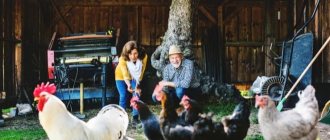Keeping chickens at home: care tips for beginners
Organizing poultry farming at home is not so difficult, the main thing is to properly equip the premises for the birds and take care of a complete diet.
Let's start with the premises:
- Maintaining temperature conditions. The optimal temperature is 23-25°C. In such conditions there will be good egg production. In winter, the temperature should not be below 15°C.
- Ventilation. The room should have vents, but it is better to equip a hood with plugs for such purposes.
- Flooring. Mostly made of wood or adobe. Cover the floor with bedding made of sawdust, straw, hay, etc. In winter, the bedding is compacted to save heat.
Concrete floors are contraindicated; they are cold and increase dampness in the room.
Accommodation. For every 5 chickens there should be 1 sq. m.
Lighting. To obtain high egg production when daylight hours are shortened, additional lighting is needed. The day is lengthened only after molting.
Perches. Should be located a maximum of 1.2 meters from the floor near the window. There is approximately 20 centimeters of perch per individual. The distance between the crossbars is maintained at 50 centimeters.
Lifting perches on hinges will make cleaning indoors easier.
Nests. Set up in darkened corners of the chicken coop. One nest is enough for 5-6 individuals. For convenience, use wooden boxes and fill them with shavings, straw, and hay.
Laz. In addition to the main door to the chicken coop, an additional hole is made so that the chickens can freely go out onto the walking yard.
Feeders. There should be 10-15 centimeters of feeder per individual. It is recommended to place them above the floor, at a low height. Chickens will not rake food.
Drinking bowls. The best option is 5-6 liters. In the summer, the water is changed quite often to avoid attenuation.
Containers with ash. Chickens are attacked by various parasites. Ash baths will prevent their appearance. In addition, chickens enjoy such baths.
For full development and good egg production, chickens should be provided with proper nutrition:
- Cereals. The grain contains small amounts of protein and should be mixed with protein feed. In summer, it is recommended to feed oats, millet, barley - they improve egg production. In winter, for gaining weight and saving energy - wheat, corn and buckwheat. Cake and meal, beans are a good protein supplement.
- Green food. Contains many vitamins and minerals. It is recommended to give no more than 20% of greens per day, since most of the birds are eaten on the range. When kept without walking, dill, clover, young peas, and alfalfa are introduced into the diet. Nettle is considered the most valuable.
- Roots. It is recommended to add carrots and beets, pumpkin and turnips, and potatoes to the diet. Vegetable crops are boiled and added to wet mash. You can also put table scraps in them.
- Animal feed. Dairy products are given to chickens for full development. Good additives include earthworms, crushed bones, fish and meat and bone meal.
DIY bird cage
You can build a cage for chickens at home as follows:
- We make a frame. Mostly a metal corner is used, but wood is also suitable.
- For construction you will need vertical posts - 4 pieces, long crossbars - 6 pieces, short crossbars - 6 pieces.
- The crossbars are connected to each other - the frame is ready. For stability, you can add a couple of vertical posts in the middle.
- The height of the compartment is approximately 60 centimeters, width – 2 meters, depth – about 65 centimeters.
- The bottom is made of durable mesh, and a slight slope is made so that the eggs roll into the egg collector.
- The roof and back wall are made of plywood.
- The side walls are installed on hinges, bolts are added - the door is ready.
- Feeders and drinkers are attached outside.
Laying hens
The size of the cage directly depends on the size of the chicken. To make living comfortable, there should be approximately 0.2 square meters per hen. m, stocking density – 5-6 heads.
When kept in cages, laying hens will need artificial lighting for good egg production. It should be distributed evenly throughout the cage room. Very bright light is prohibited so that the bird does not become stressed. Initially, the photoperiod lasts 13 hours, then it can be extended to 17 hours. The increase is made gradually.
Diet of laying hens when kept in cages:
- wheat;
- sunflower cake;
- calcium carbonate;
- vegetable fats;
- vitamins and minerals, salt.
Broilers
The planting density of a broiler in a cage should be 1 square meter. m for 10 heads. For such care, it is better to give preference to cellular batteries.
Basically, broilers are raised for meat. Pursuing this goal, the light regime lasts around the clock for 3 weeks. By the end of cultivation it can be reduced to 17 hours.
Diet of cage-fed broilers:
- crushed and whole grains;
- cellulose;
- fats;
- calcium;
- vitamin complex.
Grain should make up approximately 65% of the total feed. To gain weight, birds are given free access to feeders around the clock.
The nuances of keeping laying hens and broilers together
It turns out that keeping poultry like this is quite possible if you follow a number of rules.
Firstly. In the poultry house you will have to build a couple of tiers and a large number of perches so that all the birds can fit on them. Broiler chickens, due to their large size, will occupy the lower row of perches, which can be made in a recess in the floor. But laying hens calmly climb onto the top row of perches.
Secondly. It is imperative to maintain cleanliness and order in the poultry house, as this is the key to good health of chickens, their good productivity and active growth. When keeping this poultry on the floor, soft bedding should be laid, which should be changed when it gets dirty.
Third. There should be no drafts in the room, but at the same time the chicken coop should be equipped with good ventilation. In addition, good gangways are provided from the perches, and nests are equipped in the corner opposite the door. The poultry house should be disinfected at least several times a year.
Perches for laying hens should be 0.3 * 0.3 m in size and at least 0.6 m in height. But broilers can be placed on the floor, providing them with a thick floor covering. The temperature in the poultry house should be maintained at around 22 degrees Celsius.
Add a comment Cancel reply
You must be logged in to post a comment.
Request a call from a professional consultant. We will answer all questions, select equipment, and help you save!
All equipment can be purchased in 0% installments without overpayment.
The manufacturer may cancel the warranty for equipment if it is not purchased from an authorized representative.
Are you interested in screw piles for a fence, bathhouse or house? Watch our new video! In this issue we talked with Dmitry Vinogradov, director of the North-Western Pile Structures Plant. He told us a lot of interesting things about screw piles: Is it possible to install screw piles with your own hands? For what purposes is a foundation on screw piles used? Which ones exist?
Manufacturer of septic tanks and storage tanks Termite is expanding its range. Now you can buy: Septic tank Termite Pro 6.5, Septic tank Termite Pro 8.5, Storage tank Termite 6.5, Storage tank Termite 8.5. Septic tanks and Termite storage tanks are made from linear low-density polyethylene (LDL). This material is resistant
At the end of 2018, we installed a heating system for the owner of the popular YouTube channel “House in the Village.” He made a video about this, and in the comments under the video, Maxim’s subscribers asked us many questions about the work performed. It's time to answer them.
As a rule, all work in the garden is carried out until mid-October. But in order to have time to prepare the site for winter, you need to immediately collect late harvests of vegetables. Therefore, they are trying to complete this work by the end of September.
Not all gardeners know that strawberries should be fertilized several times in one season. In this case, special attention should be paid to autumn fertilization to ensure a rich harvest for the next season. It was the preparation of strawberries for winter that experienced agronomists spoke about.
Of all the bird species, chickens are the most popular in many regions. This is due to their unpretentiousness, high reproductive rate, rapid weight gain, immunity to low temperatures, and also the fact that they constantly lay eggs and are a source of dietary meat with excellent taste.
Therefore, poultry is raised not only by residents of the countryside, but also by summer residents who go back to city apartments for the winter. The latter have to cut off the laying birds each time and then buy new ones, which creates not only costs, but also inconvenience. Therefore, experts explained how you can transport chickens to a city apartment for the winter without creating difficulties for neighbors and the owners themselves.
Keeping chickens on the balcony
It should be noted right away that the best place to keep chickens would be a balcony, since birds require ultraviolet radiation and fresh air. Therefore, despite the chickens’ tolerance to low temperatures, it must be glazed. Otherwise, the cells will have to be wrapped in film and additionally heated.
The presence of window frames on the balcony will provide sound insulation, and this is the key to the absence of complaints from neighbors. It is worth noting that chickens are not such noisy birds, but it is still necessary to ensure comfort for people living in neighboring apartments.
Aviaries or cages for chickens
Many people know that keeping chickens outside ensures more active laying of eggs, which are rich in vitamins. But you shouldn’t let chickens roam freely around your balcony or apartment. Therefore, an aviary or cages are suitable as an alternative.
The latter can be made from multilayer plywood, at least half a centimeter thick. But the wood material will need to be coated with drying oil. Each cell should be 70 centimeters high and 60*70 centimeters wide. It is necessary to house two chickens in one cell - this will provide convenience in caring for the birds and cleaning up the droppings. The main thing is not to forget to clean the cages regularly, otherwise the smell will instantly spread throughout the apartment, and then may be heard by neighbors.
Nests for chickens in the apartment
A place for laying eggs can be made from any materials that are at hand. It is also worth remembering that there is a perch for which an ordinary stick is used. It is better to place a separate sheet of plywood under the perch, which will ensure quick removal of droppings. The same goes for cleaning the roost.
Are you interested in screw piles for a fence, bathhouse or house? Watch our new video! In this issue we talked with Dmitry Vinogradov, director of the North-Western Pile Structures Plant. He told us a lot of interesting things about screw piles: Is it possible to install screw piles with your own hands? For what purposes is a foundation on screw piles used? Which ones exist?
Manufacturer of septic tanks and storage tanks Termite is expanding its range. Now you can buy: Septic tank Termite Pro 6.5, Septic tank Termite Pro 8.5, Storage tank Termite 6.5, Storage tank Termite 8.5. Septic tanks and Termite storage tanks are made from linear low-density polyethylene (LDL). This material is resistant
At the end of 2018, we installed a heating system for the owner of the popular YouTube channel “House in the Village.” He made a video about this, and in the comments under the video, Maxim’s subscribers asked us many questions about the work performed. It's time to answer them.
As a rule, all work in the garden is carried out until mid-October. But in order to have time to prepare the site for winter, you need to immediately collect late harvests of vegetables. Therefore, they are trying to complete this work by the end of September.
Not all gardeners know that strawberries should be fertilized several times in one season. In this case, special attention should be paid to autumn fertilization to ensure a rich harvest for the next season. It was the preparation of strawberries for winter that experienced agronomists spoke about.
- Author: Maria Sukhorukikh
Rate this article:
- 5
- 4
- 3
- 2
- 1
(0 votes, average: 0 out of 5)
Share with your friends!
Brooders for raising chickens
Chicks that are born are quite sensitive to the environment. Temperature fluctuations, changes in humidity, low lighting, and drafts are unacceptable for them. A brooder will help solve all these problems. Design Features:
- Small dimensions, length – meter, width and height – 0.5 meters.
- Made from dense material to provide thermal insulation. Shouldn't get wet.
- A removable pallet is added to the structure, which is filled with a layer of sand. This will make it easier to change the layer contaminated with droppings.
- Feeders and drinkers are equipped in such a way that chickens cannot turn them over or trample inside.
- 40 or 60 W incandescent lamps are installed.
- The temperature is maintained at about 20-26°C.
With a brooder size of 100x50x50, the population can be up to 60 chicks.
How to get eggs from broilers
Broilers are a specially crossed breed of poultry. Chickens of meat (Cornish) and meat and egg (Plymouth rock) breeds are used as parents. During breeding, the best characteristics of the maternal and paternal lines are selected. The resulting hybrids have a special physiology. With proper nutrition, chickens weigh 2 kg at 1.5 months. And at 50-60 days of life they are ready for slaughter. The weight of such a chicken reaches 4-5 kg.
Broilers are not raised at home to produce offspring. Their fate is to quickly gain weight. There are specialized breeds for eggs. Therefore, there is no need to “reinvent the wheel”. Laying eggs by broiler birds will lead to problems: disease and death. Domestic breeders are trying to correct this problem by creating universal crosses.
When can you get your first eggs? The period of puberty in broilers occurs much later than in ordinary laying hens - at 6-8 months. Some individuals begin to lay eggs when they are one year old.
Due to genetic predisposition, eggs have two yolks. They cannot hatch into a living chicken. And if there are any offspring, they die at an early age.
Broiler chickens rarely hatch
At home, broiler chickens most often lose the genetic characteristics of their parents. The offspring are larger than ordinary chickens. They lay few eggs (2-3 per week) and are obese.
But if you decide that you need eggs from this breed of chicken, remember some subtleties.
- Include plenty of greens and shells in your diet. Birds are prone to obesity, so a diet is necessary. Don't allow yourself to overeat.
- There may be problems with the oviduct. Monitor your pets' behavior. If the bird does not eat or drink for several hours, this is a cause for concern. Large egg shape and excess weight will become a problem for the health and life of the bird. Gently massage the abdomen so that the egg can come out.
If desired, you can breed broilers and get large eggs with two yolks from them. However, the profitability of such production is much lower than that of conventional layers. And health problems will overshadow the whole process. As a result, you will lose not only the egg, but also several kilograms of meat.
As professionals note, when broiler chickens reach puberty, the meat loses its distinctive taste. It becomes dry, hard and has an unpleasant aftertaste.
The meat of mature broilers is very tasteless
Useful video
Watch the video on the topic:
If you find an error, please select a piece of text and press Ctrl+Enter.
There are not so many people who want to keep a chicken in a city apartment, but such people still exist. The reason for this desire may be both a love for these useful birds and a practical goal, which is constant access to fresh eggs and organic meat. But keeping chickens at home is not an easy task, which is accompanied by many restrictions and features, which we will consider in the article.
Possible problems and their solutions
Keeping laying hens and broilers in the same coop can cause many problems. After all, breeds can behave aggressively towards each other. Moreover, each of them has an advantage: broilers are superior in weight, and laying hens are superior in terms of activity.
If fights break out between them, there may be losses on both sides. Sometimes chickens are so aggressive that they peck individuals to death. Therefore, if you need to introduce representatives of another breed, you need to do this at night. This way they will spend time together until the morning, which will reduce the risk of fighting between them.
Broiler and laying hens have different daily routines. While the latter are actively walking in the walking area, broilers take their places in the chicken coop.
Therefore, it is better to make baskets and cages for them in the lower part of the room, where other birds will not disturb them.
Sometimes in the morning after opening the coop, a farmer finds dead chickens on the ground.
Since broilers sleep in the lower part, and laying hens on top, a crush may occur, during which some birds die.
Therefore, you need to equip the chicken coop so that the individuals do not interfere with each other. To do this, the lower tiers are deepened and a stepladder is placed along which the hens can climb up.
Fights between roosters of different breeds are often observed. Moreover, they can bite to death. Therefore, you need to either keep only roosters of the same breed for all the chickens, or make different walking areas.
Walk
To properly organize walking, you must adhere to the following recommendations:
- When keeping chickens in a chicken coop, walking is organized. Usually the enclosure is built on the south side.
- To do this, the area is fenced with a net (for example, chain-link).
- For laying hens the height is 2 meters, for meat breeds 1.8 meters is sufficient.
- In the walking yard there are drinkers and feeders, and a container with fine gravel.
The productivity of chickens in the fresh air increases, they lay eggs more often, and the meat is of high quality.
Walking can also be free. Chickens go out for a walk whenever they want and also come back. This method allows the farmer to save on feed, but the garden will be at risk.
Conditions for keeping chickens in the first weeks
Typically, broiler chickens are purchased at one day old. Naturally, at this time they are still completely dependent on the hen. When we bought the first crosses, we figured out how to make an artificial “mother” for them.
I took a three-liter jar and sewed “clothes” for her from an old woolen blanket. I cut out a rectangle from warm fabric according to the height and diameter of the jar, but with reserves. To prevent the chickens from accidentally pecking the threads, I folded the top and bottom of this model and hemmed it. The result is a cover.
Then I cut out another piece of the same size, cut it from the bottom with a fringe, not reaching the top 5 cm. The width of each strip turned out to be 2-3 cm. I scorched the edges of this workpiece over a flame so that little pranksters could not pull out the threads from here. Then I created two more such parts and sewed them to the top of the can. In this case, the resulting fringe was located at a distance from the shoulders of the can to the bottom.
I pour water into the jar at about +45 °C. Naturally, the water in the jar constantly has to be changed to warm, because it will cool. The chickens climb here, as if under the feathers of a laying mother, and finger strips of fabric with their noses in order to penetrate deeper under the wings of their improvised parent. They are warm and cozy. About 10 yellowthroats can easily fit around such a jar.
This is exactly how many chickens it is advisable to buy for breeding broilers if you will keep them in a house or apartment for the first weeks. And if you have the opportunity to keep them in the barn at once, then you can purchase 20 pieces. But keep in mind that you need a dry and very warm barn. Most likely, it will need to be heated for the first 3 days. A bedding of hay and straw is laid on the floor, and perches are made over time. But that's all later.
The most important for broiler chickens are the first three days of life. These days, the temperature of the space surrounding them should be +32... +35 °C (for this, a “mother hen” jar is needed). Then the temperature is gradually lowered to normal room temperature (I replenish the warm water in the jar less and less often, and then remove the “mother hen” altogether). And when the chickens fledge, you can keep them on a glassed-in balcony during the day, if the air temperature there does not drop below +20 °C.
In the first days of life, broiler chickens are constantly in a box. On the third day, new residents can be fenced off part of the kitchen or barn so that the little crosses have the opportunity to exercise during the day. At night, the chickens are again collected in a box where there is bedding, food, and water.
It is important to maintain hygiene measures in the box. The feeders are hung so that they are at the level of the chickens' heads.
Then the little pranksters won’t be able to shit here and trample the food under their feet.
For the bottom layer of bedding, you can use newspapers; for the top layer, regular gray wrapping paper, A4 sheets or regular diapers are suitable. As soon as the litter becomes unusable, it all needs to be rolled up, thrown away, and replaced with a new one.
As for the light, our chickens have enough daylight, which falls from a nearby window. But we buy them in mid-April, when daylight hours are already long enough.
If you keep chickens in a plywood box, you can attach an incandescent lamp to it, which will provide both warmth and light to the chicks. But we need to take care of safety precautions so that inquisitive sneaks don’t accidentally get burned. Therefore, the lamp is hung at a sufficient height. It is better to place it on one side of the plywood box so that the residents of the “house” can move to the other if they get hot.
Broilers do not require night lighting; a 17-hour daylight period is sufficient for them.
At the age from birth to one month, broilers are given compound feed labeled PK-5, and when the chicks are 30 days old, PK-6 compound feed is introduced into their diet
Why turkey and chicken can't be neighbors
If we consider the issue of keeping poultry together in general terms, then the proximity of chickens and turkeys is the most successful, unlike other birds, since both species prefer to sleep on wooden perches and build nests at the top. But that's where their similarities end. In all other respects, these birds are completely different, from the diseases that they can give each other to the dissimilarity of morals.
Character traits
Different personalities are one of the main reasons why turkeys and chickens cannot get along together. Chickens are more active and mobile, in addition, some breeds are quite aggressive, so they can be the first to attack turkeys, despite their formidable appearance. In particularly conflicting cases, chickens can simply peck at them. At the same time, male turkeys love to show character and often get into fights with chickens. And this is a serious matter - given the dimensions of both types, it is not difficult to predict who will emerge victorious in such an unequal battle.
Conditions of detention
Among all types of poultry, turkeys are considered the most demanding to keep. Firstly, they are quite large (some broiler breeds can reach a weight of 30 kg), and therefore they need a lot of space. And, secondly, they are very sensitive to cold, dampness and drafts. When arranging a poultry house, it is necessary to pay a lot of attention to creating favorable conditions - the room should be clean, dry, well ventilated, and, preferably, heated.
Therefore, it is necessary to always monitor the cleanliness of the floor mat and change it regularly. Considering the high sensitivity of turkeys’ paws to cold, warm natural materials should be used as bedding: hay, straw, dry soft sawdust.
Chickens are less demanding on conditions. They feel comfortable in small chicken coops, the main thing is that there are perches for sitting and sleeping, as well as nests for laying eggs. Chickens live well in flocks; in cold weather they often crowd together to keep warm, therefore, any room can be suitable for keeping them, even without heating, which is completely unacceptable for turkeys.
It will also not work to feed turkeys together with chickens. First of all, because turkeys, due to their size, eat a lot and quickly, which is why slow blackbirds do not have time to grab the food and remain hungry. There is a more significant reason - these are different biological characteristics of the birds’ bodies. In turkeys, the pH level is shifted towards the alkaline side, while in chicken it is almost neutral. This circumstance dictates certain feeding rules.
If a chicken, in principle, can eat grains and pasture, then turkeys require a balanced and varied menu, in which not the least place is occupied by products that equalize the pH: chitin and bitter plants, which are contraindicated for chickens.
Diseases
It is known that turkeys are more susceptible to diseases than other birds. And this is due, first of all, to the same increased pH level. It is because of this that bacteria that enter the turkey’s body develop faster than those of chickens and other birds. Elevated pH levels cause a disease such as histomoniasis, which leads to inflammatory processes in the liver, stomach and intestinal tissues. Chickens suffer from histomoniasis much less frequently, however, being a carrier of the disease, they can easily infect their neighbors.
There is also a downside to this situation. It is believed that turkey feces contain many microbes, in particular, pathogens of infectious diseases, and since chickens often row and peck various debris, there is a high probability that these microbes can enter their body. There are cases where the entire population of chickens died from infectious typhus.
Another danger that awaits both species of birds when living together is helminths, which they can become infected with from each other. Heterakis gallinarum is the most dangerous microorganism that chickens can infect turkeys with. For the chickens themselves, these protozoa do not pose any particular danger, while for turkeys they can cause death.
How to maintain optimal temperature?
Despite the chickens’ love for warmth, they also do not tolerate heat well and stop laying eggs.
Therefore, it is important to maintain acceptable temperature conditions not only in winter, but also in hot summer
Winter insulation methods
You need to prepare the chicken coop for wintering in advance, before the onset of the first cold weather. The first step is to try to establish comfortable conditions so that frost and bad weather do not affect the chickens’ lifestyle and their productivity.
Wall insulation
Domestic chickens can catch a cold if they have been walking for a long time in the cold or in strong winds. Drafts and ice-cold drinking water negatively affect them. A favorable temperature can only be achieved by creating a warm, windproof room. It is better to build the walls of the poultry house from thick logs and cover the outside with boards.
Today there are many ways to insulate walls. At the same time, all cracks are sealed, window openings and doors are insulated. The following materials are used as insulation for walls:
- Styrofoam;
- mineral wool;
- expanded polystyrene;
- roofing felt;
- old warm clothes or blankets.
Window openings are insulated using rubber insulation tapes or window putty. The door block is installed on polyurethane foam, and the door itself is sheathed with insulation on the outside and inside, and covered with leatherette on top.
Insulation of ceiling and floor
As a rule, to thermally insulate the floor of the poultry house, it is enough to equip deep litter, which will subsequently turn into compost for fertilizers. To begin with, slaked lime (1 kg per 1 sq. m) is poured onto the floor, then an insulating substance (sawdust, large shavings, chopped reeds, peat, hay, straw, dry moss) is scattered in a layer of 5-8 cm. As soon as the litter is trampled down, it will be reported. By spring, the insulation layer will already be 25-30 cm. To maintain looseness, the litter is turned with a pitchfork from time to time.
The litter performs several functions: maintains temperature, delays the putrefactive decomposition of droppings, and serves as excellent insulation. If the top layer of litter becomes very dirty, it can be replaced with a new one. The ceiling is made of wide beams, which are laid on the walls and secured with forged brackets. The beams are covered on top with boards 40 mm thick.
Problems of shared content and ways to solve them
The main problem when introducing birds to each other is possible fights. Moreover, chickens can peck their relatives until they bleed or cause injury. These troubles reduce the growth of broilers, and laying hens are worse at laying eggs.
- You can reduce the number of fights between birds by increasing the length of the feeders or their number and placing them in different corners of the chicken coop. Then individuals of different species will contact less often.
- It is better to place such violent individuals in separate cages, and place other birds in their place.
- Separately, it is worth noting the keeping of roosters. They should be only one breed, and even better, one rooster for the whole chicken coop.
- If there are several roosters, then they should be separated into different enclosures or walked at different times.
In dense housing conditions, diseases in broilers and laying hens are not uncommon. Infectious diseases are more common due to dampness, low temperature, and drafts.
Symptoms in chickens are:
Treatment is carried out with the drugs Tetramizole, Enroxil, Baycox. The chicken coop is insulated and disinfected.
Diarrhea in broilers occurs due to both colds and salmonellosis and colibacillosis. Sick birds are isolated from the population and treatment is prescribed.
Broiler breeds are more often than others susceptible to leg diseases; when a bird falls out of the blue, an uneven gait appears. The cause of this disease lies in the lack of vitamins and microelements.
How to create conditions for keeping chickens in an apartment
In general, if a person has a large apartment, then he can easily make a chicken coop out of one room. Only in this case he will have to prepare for inconvenience, because chickens make a lot of noise and dirt. When the coop is located on a large area, the noise from the birds is not as audible.
And at home there will be a lot of noise from the chicken family, which will cause discomfort not only to everyone at home, but also to the neighbors behind the wall. Therefore, you will have to come to an agreement with your neighbors, if of course it works out. And also a good way out of this situation is to soundproof the walls, then the neighbors will not notice any discomfort from the feathered breadwinners.
Quiet and neat footrest.
Of course, chickens in an apartment are quite an expensive pleasure, but they will bring a lot of benefits. In the room where the chickens will be located, you will need to install a plastic window. Otherwise, the noise from the rooster can be heard on the street, even if the apartment is on any floor.
If a person has housing on the ground floor, then he can keep laying hens in his basement. Only it will first need to be prepared and equipped with everything necessary. Thus, no noise from the quokkas will be heard by either family members or neighbors. But how will they feel without the sun, like the prisoners of the Chateau d'If?
Why I decided to have chickens on the balcony
I didn’t delve into the details and all the nuances of keeping chickens on the balcony at that time. First, I needed to somehow digest for myself the very fact of what I saw. Chickens in the city! Until this moment, I would not have even imagined that this was possible in principle. Nonsense! And if someone had told me that within a year I myself would become interested in the topic of keeping chickens at home, I would simply laugh in their face.
But now, a year has passed. It just so happened that I was left without work for some time. I sat at home, counting every penny. Roll it in the refrigerator. It was precisely in those days that the idea came into my head to try to have chickens in my own apartment. At least I won’t die of hunger; there will always be a fresh egg on the table, I reasoned.
In addition, I believed that raising chickens in small quantities is the simplest thing. Actually, nothing is required from you. I fenced off a corner, stocked up on food for my laying hens, and then just do all you can do - collect eggs. If you want, eat them yourself, but if there is a surplus, you can sell them.
How I built a chicken coop in the corner of the loggia
I didn’t see a problem with allocating a place in the apartment for a mini-chicken coop. I had a fairly spacious glazed loggia, a third of which could have been devoted to useful work.
I immediately imagined how I would partition it with a lattice made of some kind of chain-link mesh, arranging a small door in this partition. Then all that remains is to put a feeder and a bowl of water there, after which you can safely let the chickens into the pen. All I could do was sit in a chair and “smoke bamboo,” waiting for the first eggs from them, as a reward for my righteous labors.
Perhaps it was the fact that this matter from the outside seemed quite simple to me, and pushed me to implement the idea with the chicken coop. I didn’t shelve it. True, I didn’t find chain-link in hardware stores near my house (this is definitely not a popular product for the city), but I did get a roll of wire mesh, the kind that finishing workers usually use when plastering walls.
At the moment when I was already walking around my loggia with a tape measure in my hand to determine which piece of this lattice I should cut off first, I suddenly thought: wouldn’t the amount of space be too large for several chickens? Not the area of the loggia allotted to them, but the space.
I admit, at that moment I thought not so much about the chickens themselves, but about the possibility of somehow saving on their maintenance. Although I had no experience in raising chickens, I still knew some general principles of handling poultry. It’s not for nothing that when I was a child, my parents sent me to my grandmother’s village for summer and winter holidays, and now they themselves keep chickens there!
So, for example, I knew that in winter in village chicken coops they often leave a light bulb on all night, so that at least some heat comes from it. And particularly advanced village poultry farmers even install a special infrared lamp for heating.
In the future, closer to winter, I was also going to get one like this, but even the thought of it was enough for me to draw a logical conclusion - I would have to use it to warm not so much the chickens themselves, but the under-ceiling space of the loggia! After all, heat, according to the laws of physics, rises.
After thinking a little, I decided to reduce the height of the future chicken coop to one meter, providing it with a removable lattice roof. According to my calculations, this option will provide several advantages at once. In winter, for example, you can put glass on it, which will allow you to retain some of the warm air under it.
In addition, a low roof will help solve the lighting problem. After all, city lights literally flood my loggia with light at night, which, as I thought, could disorient the chickens regarding the time of day. I assumed that if I threw a blanket over this makeshift roof at night, the problem with light would be easily solved, and my chickens would get something like a small but cozy bedroom.
The height of the balcony chicken coop should not be too high so as not to heat the air in winter. backyard chickens
Feeding
The productivity of egg-laying chickens directly depends on their nutrition. The feeding process is carried out at least twice a day, provided that the chickens have access to grass. It is allowed to feed the poultry with special feed for egg breeds, or you can prepare grain mixtures yourself.
- Stern
- Recipes
- Supplements
Compound feed pk-1
Description of food for egg breeds. Instructions for feeding laying hens Read
Compound feed pk-2 and pk-3
Mineral and vitamin compositions, feeding standards Read
Compound feed pk-4
Used to feed laying hens aged 15-17 weeks Read
Compound feed pk-5
Composition and instructions for feeding broiler chickens Read
Purina Pro
Important differences from the previous line, application patterns Start, Growth, Finish Read
Germination and steaming of barley and wheat for chickens: how to do it correctly and how to give it to laying hens
Wheat for broilers
Rules for feeding broiler chickens with wheat. Dosage for chickens from the second day of life and adult birds Read
Mash
Making mash for broilers at home Read
Rice and buckwheat
How and in what form you can use rice and buckwheat to feed chickens. Standards for adult birds and chickens Read
Bread
What kind of bread can you feed chickens and how to do it correctly Read
Fish
The product is given in limited quantities: overfeeding can cause serious harm to the bird Read
Chalk
Chalk as a food additive for chicken feed. Feeding standards for chickens, young animals and laying hens Read
Meat and bone meal
Meat and bone meal is a mandatory additive for feeding chickens, containing protein and fats of animal origin Read
Fish fat
How to give fish oil to chickens, layers and broilers. What are the benefits of the drug and are there any contraindications Read
Limestone
Limestone (dolomite) flour in the diet of chickens. Advantage over chalk and feed shell Read
Salt
Daily dosage of salt for adult birds and young animals and cases of unwanted use Read
Chickens can eat various mashes with the addition of vegetables and various herbs - dandelion, nettle, plantain, clover, alfalfa, etc. Do not forget about the need for minerals in the diet of laying hens, since they form the shells of eggs. The mineral component is provided by crushed shells and chalk, bone and fish meal.
On average, one chicken eats about 150-160 g of food per day. In the spring, the diet should be richer in whole grains and silage; in the summer it is diluted with fresh greens and grass, crushed grain, and fresh vegetables.
If there is no fresh grass in the walking yard, it is brought from other areas. If there is no access to worms and insects, meat and fish trimmings are added to the chickens' feed to ensure complete nutrition. There should also be small pebbles in the area, which act as “teeth” in the bird’s stomach and help grind large lumps of food.
Shell as a mineral supplement for chickens. What is the benefit, at what age and in what form can it be given? Look
Can broilers be given sand? More details
Chalk as a feed additive for chickens - why is it needed? Read
Feeding chickens with barley: can it be given to broilers? More details
Using whey as a source of animal protein Read
Eggshells in the diet of chickens and chickens. How to give correctly? More details
How to give fish oil to chickens, layers and broilers? Look
Feed tricalcium phosphate for adult chickens, chicks and broilers More
Each breed has its own dietary requirements, which must be taken into account before purchasing young animals. Some breeds are more demanding when it comes to nutrition, while others can be very unpretentious.
Litter processing
With proper maintenance and proper feeding, chicken droppings are rich in microelements. A large amount of it is a poisonous suspension. Processing chicken manure is an important task that needs the right solution.
The best option is to make compost. To do this, the droppings are mixed with various plant wastes (residues of vegetables and fruits, leaves, weeds), straw, sawdust, peat, shavings. Fresh plants cannot be used for compost.
Keeping chickens at home is not easy, but it is always profitable. As a result, you will not only have food, but also excellent fertilizer for your garden.
Chickens in the country are disturbing the neighbors
You can also buy a dacha and farm for your own pleasure; if you really want to start farming, then it would be best to buy your own house or dacha plot instead of an apartment, and have as many animals as you want, without disturbing anyone.
This is the first opinion, but in fact many neighbors will not like the crowing of a rooster, because people come to their dachas and gardens to relax and sleep in silence. And here your Petka is screaming like a siren.
It’s special if he’s a guy of the Yurlov vocal breed. We need to agree!
Neighbors in the dacha can drink and yell, listen to loud music until 3 am. This is the norm - this is how they rest. But for a live alarm clock at 4 o’clock, this company will tear you to shreds and scatter you around your dacha or garden cooperative.
Look at the photo of a quail in a cage in the kitchen.
In a multi-storey building, of course, you can keep laying hens without a rooster if you really want to, but do you need it? After all, you will have a lot of problems with your neighbors; they will make constant complaints and reproaches. After all, no one likes constant noise and discomfort.
Still, a house with a special place for this is best suited for keeping animals or birds, and then it will be convenient for you and will not cause any discomfort to other people.
Breed selection
Chickens at the dacha produce eggs that taste completely different, bring joy to children and teach them to work. And if the kid refuses to pick the grass for his charges, the next day he can be shown an empty nest for eggs - an educational moment.
So, it’s decided, we choose the breed of laying hens:
- Leghorn.
- Hisex breed.
- Loman Brown.
The best of them is Loman Brown. A large chicken with a stable mentality and good egg production. You can also choose white laying hens of the Leghorn or Hisex breed. The egg production of these birds is excellent if they are well fed. But in the fall it will be a pity to part with such productive laying hens. The easiest way to keep chickens in the country from hybrids. And the motley herd looks more cheerful and is more unpretentious.
Diseases in chickens kept together
If there are too many chickens in the house, they are more likely to develop various diseases. Infectious diseases are especially developed in this poultry if the room is damp, the air temperature is low, and also due to drafts.
Signs of infectious diseases in poultry:
- Rhinitis;
- cough;
- hoarseness;
- individuals are lethargic;
- loss of appetite.
The bird should be treated with the following medications:
- Tetramisole;
- Enroxil;
- Baycox.
The chicken coop should be insulated and disinfected.
Often, poultry may develop diarrhea, not only due to infectious diseases, but also due to salmonellosis or colibacillosis. All sick individuals must be isolated from the main population and appropriate treatment must be carried out.
Representatives of broiler breeds often have diseases of the limbs, which is associated with a lack of vitamins and minerals in their body. The first sign of such diseases are individuals falling out of the blue, as well as an uneven gait.











